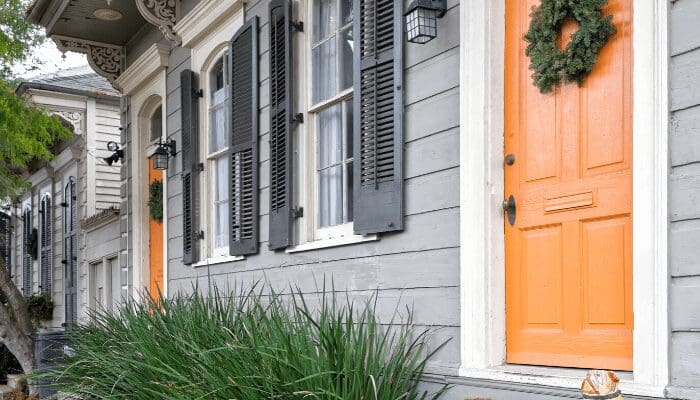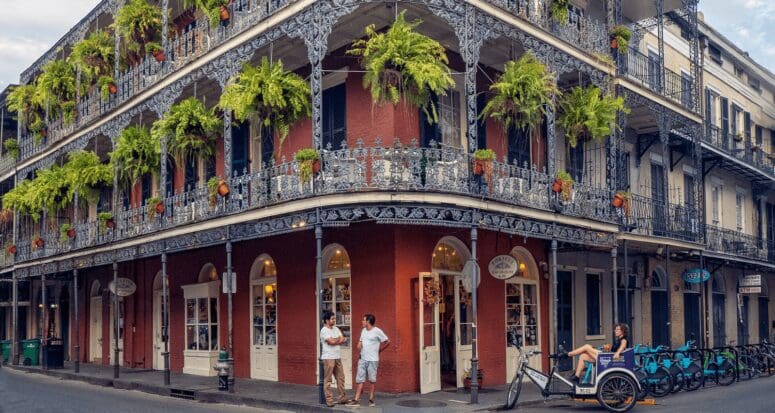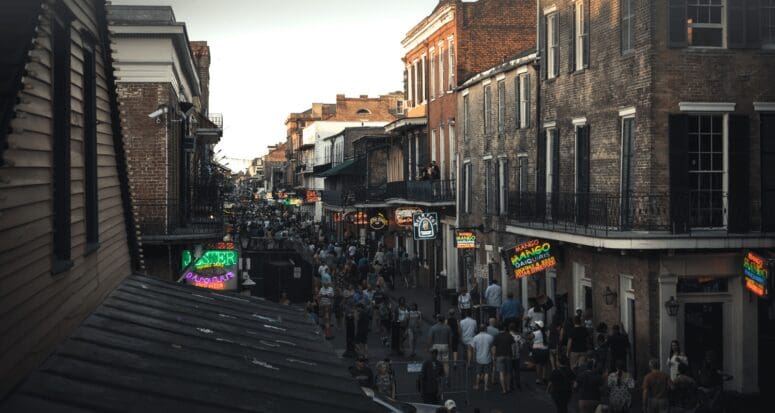A Big, Easy Guide for Buying Your First House in New Orleans
- Published on
- 5 min read
-
 Sally Tunmer Contributing AuthorClose
Sally Tunmer Contributing AuthorClose Sally Tunmer Contributing Author
Sally Tunmer Contributing AuthorSally Tunmer is a writer and content strategist with 10 years professional experience focusing on real estate, travel and the lifestyle and culture of places. She was the former editor of the official New Orleans tourism blog and is a regular contributor to neighborhoods.com. Sally is currently based in Atlanta where she drinks wine, listens to music and writes about both on her personal blog.
Anyone who’s spent more than five minutes in New Orleans knows what a special place it is. This wild and wonderful city is the birthplace of jazz, the home of Mardi Gras, a top foodie destination, and an amazing cultural melting pot.
Locals get to experience the enchantment every day, which is one of the biggest draws of buying a house in New Orleans. While it’s a fun and exciting place to live, it also has its fair share of quirks — not excluding housing options. With the small lot sizes, prevalent shotgun-style homes with limited storage and privacy, high-risk flood areas, plus the persistent termites (yikes!), finding the right place to live has its challenges.
Luckily, we’ve done the initial legwork for you, interviewing local experts with decades of experience and seeking out the top trusted sources to get all the vital intel you need for buying a house in New Orleans. Discover the best neighborhoods based on your wants and needs and learn how to manage the tricky New Orleans housing landscape with this comprehensive guide.

Know your shotgun storage options in NOLA housing
There are some traditional single-family home styles in New Orleans, but one of the most common home types is the shotgun house, where each room is laid out single-file in one straight line from front to back. This isn’t an ideal setup for privacy: it requires walking through each room to get to the next. Some of these homes are also limited in closet and storage space.
But with some creative problem-solving over the years, New Orleans residents have come up with ways to address these challenges.
- Sheds: Basements, garages, and ample built-in storage space are scant at best in New Orleans, so many homeowners erect a shed in the backyard to store whatever can’t fit in the house.
- Armoires or mobile closets: Sometimes you’ll love everything about a home until you discover the tiny closets. Create more room for your clothes, shoes and personal items with an armoire or portable clothing rack.
- Utilizing unusually high ceilings: One great feature of New Orleans homes are the high ceilings, which usually reach up to 12 feet, about four feet higher than ceilings in most other cities. Take advantage of this by installing shelves or cabinets on the vacant wall space for extra storage.
- Invest in a double shotgun: Double shotguns are common in New Orleans; the layout is similar to a duplex concept, where one house is divided into two separate units on each side. One popular investment opportunity is to purchase a double shotgun to live in one side and rent out the other.
Floods and pests
Other than the selling price, there are significant costs to consider when buying a house in New Orleans. Because of the city’s close proximity to the Gulf of Mexico (and potential hurricanes), buying a house here poses some unique challenges. Entering the house hunt armed with realistic expectations will help eliminate unpleasant surprises and better prepare you for future costs and maintenance.
Two of the biggest expenses that New Orleans homebuyers should budget for include:
- Flood insurance
According to Kara Breithaupt, a top agent in New Orleans who’s sold over 360 single-family homes in the area (and counting), flood insurance is a “massive factor.” She notes that ideally you’ll be in an X flood zone where flood insurance is optional, but you should always carry it.”In those low-risk flood zones, insurance would be about $450 a year, but some people pay $6,000 or $7,000 a year in an A, or high-risk, flood zone. In those areas, any new construction is required to be built above the base flood elevation — that’s where you’ll see a lot of substantially raised homes.” - Termites:
The main pesky critters to plague New Orleans homes are the dreaded wood-eating termites. “It’s not a question of if there are termites, it’s a question of when,” explains Breithaupt. That’s why it’s important to get a termite inspection in addition to the standard home inspection

The great outdoors in New Orleans
Many Americans prefer homes with a large yard or outdoor space, whether that’s due to the desire for extra room between neighbors or more land to expand or build on. However, in New Orleans, that can be hard to come by. Common lot sizes are 30 by 100 feet, and there is generally not much room between neighboring houses.
As a result, homeowners spend a lot less on landscaping and lawn maintenance. What New Orleans homes lack in sprawling land and acreage, they make up for in charming courtyards and the abundant lush tropical plants that serve as built-in curb appeal.
It doesn’t take much to dress up the natural available outdoor features on a given property. Details like string lights and old brick lining garden beds go a long way.
In NOLA, style matters
Modern and renovated New Orleans interior design tends to be on trend with a lot of other parts of the country. New construction and renovations are mostly all white and gray with white ceilings, gray walls, white trim, and white interior doors.
However, because New Orleans is a very historic, colorful, and whimsical city, a lot of buyers don’t want that whitewashed look and prefer to embrace the character and historical aesthetic of the city. This usually means bright interior and exterior colors, pine wood flooring, exposed brick, restored old fireplaces, transoms above doors, and corbels on the exterior.
Popular exterior modifications depend on whether the house is in a historic district. There are a number of historic districts in New Orleans, some of which are regulated under full control and some of which are partially controlled. If it’s a fully controlled historic district, you can’t alter the exterior at all — including windows and doors — except for paint color.
Whether the houses on the market are newly constructed or historic, buyers want to see attractive, modern kitchens and bathrooms.
And whether a buyer should pay more upfront for certain cosmetic upgrades or execute desired modifications themselves after closing depends on the house and the modification, says Rosalyn Bryant, who founded Bryant Appraisal Services in 2010 and was named NOMAR Affiliate of the year in 2019 as well as serving on several NOMAR committees.
“If it’s cosmetic, they for sure should do it themselves so they can make the home their own,” Bryant suggests. In terms of necessary repairs, she recommends that buyers handle only the repairs that they feel comfortable managing.
The current state of New Orleans housing
Other than New Orleans being a magical place, the local economy is also in good shape. In the first five months of 2019, the city gained 6,900 jobs, and it gained a total of 15,000 jobs in the past two years, according to the New Orleans Metropolitan Association of Realtors (NOMAR).
They attribute the healthy housing market, high real estate demand, and thousands of New Orleans housing sales in the past year to this significant job growth.
According to NOMAR, the average price of a house in New Orleans in 2019 was $261,763. Since Hurricane Katrina, housing that was affected by flooding was categorized by fair/poor conditions, but as NOMAR reports, “as of 2019 there are not enough Fair/Poor condition sales to substantially affect the housing price trend.”
New Orleans has largely rebounded from the devastation of Hurricane Katrina in 2005, indicated in part by the absence of any significant amount of remaining damaged houses.
Housing prices decreased in 2019 in some of the most appealing neighborhoods to live in New Orleans, including Algiers Point, Marigny, Bywater, French Quarter, Mid City, and the Garden District. Some of these neighborhoods, including the French Quarter, Marigny, and Garden District, are among the most expensive to buy a house in New Orleans, so buyers who want to get a good deal in those areas should try to act (if they can) when home prices plateau or start to decrease.
Not sure how much house you can afford to buy? Use HomeLight’s simple home affordability calculator to figure it out.

Choosing the best New Orleans neighborhood for you
If you want to be close to all the action
Because New Orleans is a city full of life and activity, where you choose to buy a house will reflect that — in some neighborhoods more than others. The French Quarter is bordered by the Mississippi River on one side and is located right in the height of the action, including Bourbon Street and other major cultural corridors like Royal Street and Chartres Street.
Here, you’ll find street performers, groups of tourists exploring, ghost tours, shopping, galleries and of course plenty of restaurants and bars. While this is truly the neighborhood that doesn’t sleep — quite literally: there are many places open 24 hours — there are still residential sections where many people proudly call the French Quarter home.
If you have your heart set on a historic home
New Orleans is a city with a long, rich history, and many neighborhoods have their own preservation societies to protect that. The French Quarter is a 100%-historic district, and just past it is the Marigny.
The Marigny is a beautiful, quirky neighborhood with two of the best strips for music, entertainment and dining: Frenchmen Street and St. Claude Avenue. Within the neighborhood are beautiful and unique historic homes.
The Garden District, upriver from the French Quarter, is another lovely historic neighborhood with some of the more grand homes in New Orleans and lush with tropical plants and ornate home gardens. In between the Garden District and the Warehouse District is the Irish Channel, another fully historic district and the headquarters for St. Patrick’s Day festivities each year.
Other major historic districts with covetable homes include St. Charles Avenue, Treme and Bywater.
If you want to be near the best schools
Mid-City is one of New Orleans’ largest neighborhoods that’s more affordable, laid back, located by the expansive City Park and has great schools, according to its A rating on AreaVibes.
Lusher Charter School is consistently rated the top public school in New Orleans, located in Uptown close to the university area, where Loyola and Tulane are located.
Another top-rated public school is the International School of Louisiana in the Lower Garden District. Benjamin Franklin High School, located on the University of New Orleans campus in Lake Terrace, is another one of New Orleans’ best schools.
If you can afford a luxury pad
Luxury housing market prices started softening in New Orleans in 2018, when there was a surplus of homes in New Orleans above the $700,000 price point that were on the market for 14 to 24 months, significantly longer than the average 3 to 6 months in the city.
If you have a larger budget, the time to find a deal on a beautiful, 4,000-square-foot home in a sought-after neighborhood is when price growth has stagnated in these neighborhoods: the Garden District, Uptown, French Quarter, Marigny, and Bywater.
If budget comes first
If swanky digs don’t happen to be in line with your current financial situation, there are plenty of other opportunities to find a deal when buying a house in New Orleans.
Breithaupt says the neighborhoods with the best housing deals in the $200,000 to $300,000 range as of 2019 are Central City, Hollygrove, New Marigny, and New Bywater. For a step up in price point, “generally homebuyers can get something pretty great in the $400,000-$450,000 price point as far as single-family homes in most areas of New Orleans,” she says.

The best time to buy a home in New Orleans
Generally the spring months of March, April and May — as long as it’s after Mardi Gras —are when the market is traditionally the busiest. During this time is when there are the most inventory and options for buyers, but they might also end up paying more.
Why use a top agent to buy a house in New Orleans?
Purchasing a home is one of the biggest financial decisions that most people make in their life, so it’s critical to be as informed as possible about each step of the process and to hire an agent who knows the New Orleans market inside and out.
According to data from HomeLight, top buyer’s agents in New Orleans save their clients $69,134 on their new home and buy 1.7x more houses than the average area agent.
“There is a lot behind the scenes that the buyer is not going to be aware of or know how to navigate,” says Breithaupt. Some of these hurdles include insurance, taxes, inspections, negotiating price with the seller, and, of course, finding the best property based on the buyer’s criteria.
This logistical coordination, knowledge, and guidance are the invaluable services a Realtor offers. Not only that, but buyers don’t pay out-of-pocket commissions, so there is really no reason why a buyer wouldn’t have a real estate agent represent them.
Buying a home in New Orleans is a lot like living in New Orleans: you’re going to fall head over heels with it, but there’s going to be a little bit of baggage from its past and some weird quirks to work through before you inevitably find your dream home — because in the end, there’s simply nothing else like it.
Header Image Source: (NICO BHLR/ Unsplash)
